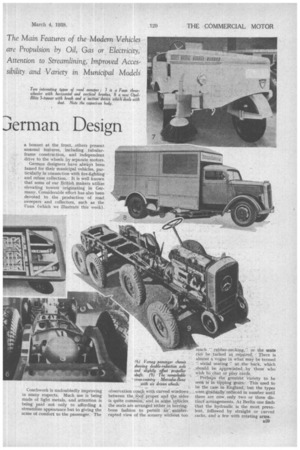Some Tendencies in 3erman Design
Page 38

Page 39

If you've noticed an error in this article please click here to report it so we can fix it.
The Main Features of the .Modem Vehicles are Propulsion by Oil, Gas or Electricity, Attention to Streamlining, Improved Accessibility and Variety in Municipal Models HAVING dealt last week with the most notable of the new products at the Berlin Show, it may be of interest to generalize on the leading characteristics of ' German industrial and passenger vehicles. A point to be. _remembered is that, in Germany, in 1932, the motor industry, as a whole, was the most backward of all the major trades; now, it is practically in the forefront. This may be partly due to the fact that, since that time, there has been a 50 per cent.. increase in the average of 'income of individuals, combined with stable prices and' currency ; actually, there is at present a shortage Of skilled labour.
Iii connection" with the 'employment
of alternative fuels, there may have been under-surface developments, but „we did not notice any startling innovations, Certainly, gas producers, where used on vehicles, are particularly neatly installed, sometimes being built into the cab and, at other times, being hidden away at the back of the vehicle.
A few vehicles are equipped with cylinders, of gas, but, it would appear that the oil engine is still. holding its owns In one or two cases, however, engines have been so arranged as to be easily convertible from oil to gas.
Perhaps the greatest development lies in the battery-electric vehicle, ranging from quite light models to six-wheelers
carrying 5 or 6 tons. There is certainly no lack of originality in these machines, for whilst some are much on the lines of the ordinary lorry, the electric-control gear being mounted under
a bonnet at the front, others present unusual features, including tubularframe construction, and independent dtive to the wheels by separate motors.
German designers have always been famed for their municipal vehicles, particularly in connection with fire-fighting and refuse collection. It is well known that some of our British makers utilize elevating towers Originating in Germany. Considerable effort has also been devoted to the production of road sweepers and collectors, such as the Faun (which we illustrate this week).
Coachwork is undoubtedly improving in many respects. Much use is being made of light metals, and attention is being paid not only to affording a streamline appearance but to giving the acme of comfort to the passenger. The observation coach with curved windows between the, ioof proper and the sides is quite comnion, and in some vehicles the seats are arranged either in herringbone fashion to permit an uninterrupted view of the scenery without too
much " rubber-necking,”. or the math can be ,turned as required: • There is almost a vogue in what may be termed '! social seating '-' at the back, which _should be appreciated,by. those who wish to chat or play cards.
Perhaps the greatest variety to be seen is in tipping genrs.. This used to he the case in England, but the types . were. gradtially reduced in number until there are now only two or three distinct arrangements. At Berlin one finds that the hydraulic is the most prevalent, followed by straight or curved racks, and a few with rotating arms.




















































































